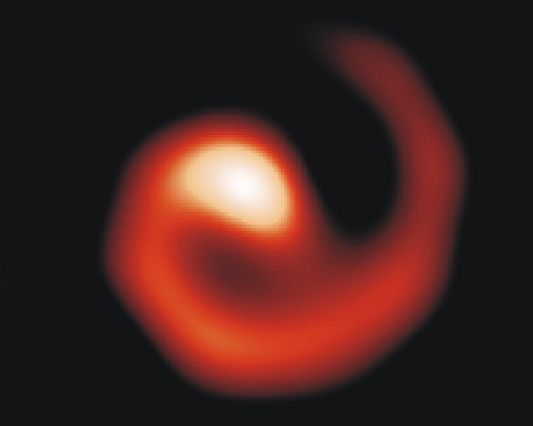Credit & Copyright: U.C. Berkeley Space Sciences Laboratory,
W.M. Keck Observatory
Explanation:
Like a cosmic lawn sprinkler, dust streaming from a rotating
star system creates a pinwheel pattern in
this false color infrared image.
Astronomers discovered the surprising star dust scenario using
a sophisticated interferometer and
the 10 meter Keck I telescope
to observe the bright Wolf-Rayet star WR 104.
Wolf-Rayet stars are thought to be massive objects on
the brink of a cataclysmic supernova explosion - having grown
so hot and bright that their intense
light begins to drive material away in a stellar wind.
The problem is, their starlight would also be so intense that any
dust flakes should be destroyed!
A possible
solution to this
dusty dilemma
is that a companion star exists hidden in the
bright central region,
generating wind interactions which shield
a relatively narrow dust forming region from the light of WR 104.
As the binary system rotates,
the spray of surviving dust particles appears to spiral outward.
1999 2000 2001 2002 2003 2004 2005 2006 2007 2008 2009 2010 2011 2012 2013 2014 2015 2016 2017 2018 2019 2020 2021 2022 2023 2024 2025 |
Yanvar' Fevral' Mart Aprel' Mai Iyun' Iyul' Avgust Sentyabr' Oktyabr' Noyabr' Dekabr' |
NASA Web Site Statements, Warnings, and Disclaimers
NASA Official: Jay Norris. Specific rights apply.
A service of: LHEA at NASA / GSFC
& Michigan Tech. U.
|
Publikacii s klyuchevymi slovami:
dust - Wolf-Rayet star - hot star - star - binary star - dvoinye sistemy - pylevoi disk
Publikacii so slovami: dust - Wolf-Rayet star - hot star - star - binary star - dvoinye sistemy - pylevoi disk | |
Sm. takzhe:
Vse publikacii na tu zhe temu >> | |
